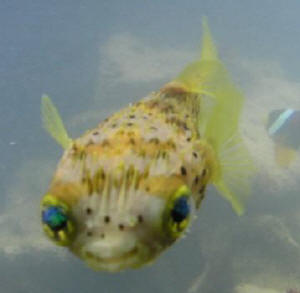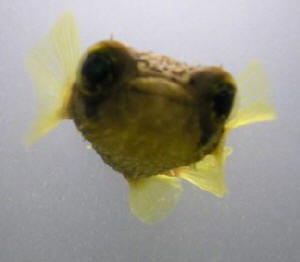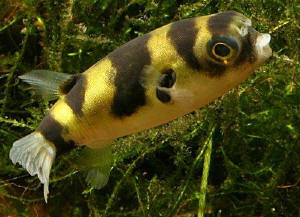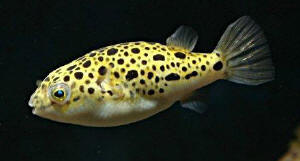|

By Justin Petrey
 |
|
This Diodon Holocanthus is a great
example of one of the species that does not always exhibit the same
signs as other puffers. Note the iridescent sheen on the eyes.
This is a clear indicator of health, as is the straight back. A
bent or hunched Diodon puffer is generally too cramped and needs a
larger space. Also the colors are bright and well defined.
Photo by Justin Petrey |
You know it, you’re
guilty. If you are reading this section you have been bitten by the
friendly fat-dog-like antics of a Pufferfish. Be it a Tetraodon, a Diodon
or even the Ostraction. I do not know why nature gave such cute looks to a
fish that can be so aggressive! I think they were intended as “aquatic
dogs”, as we all know how hard it is to punish a cute face. They win hands
down for begging and being evil, be they small or large!
I love my Porcupine
Puffer as I have every Puffer that I have ever had. I have, unlike many
hobbyists, been willing to experiment with tank mates and training after reading
several articles on the ability and success that several aquarists had training
a Diodon histrix to respond to a sort of “sign language”, so that it would not
eat the food intended for the Eel with whom it was housed. I began a
series of tests and began experimenting with medication practices as well.
This gave me a “fin up”, if you will, on keeping Puffers because now I had a
“trained” animal whose responses to my actions told me volumes about its health
and stresses.
Here are some
major signs puffers have to tell us what’s on their minds:
-
The belly:
The universal way to tell if the Tetraodon species is stressed, or sick.
As a rule, a white, fat belly is an indication of a happy, healthy Puffer.
Diodon species do not have this telling sign; subsequently their health is
harder to gauge.
-
The eyes: A
healthy Puffer is always curious, and will explore the tank, looking for
food, or anything that attracts its attention. If it favors one eye or
swims the tank aimlessly without normal “stop-and-investigate” procedures,
it is a sign of possible stress, illness and/or blindness.
 |
|
Another Photo of Diodon holocanthus.
This photo shows the relatively flat belly of this species as they
digest food more rapidly. A concave belly and shrunken areas near
the tail are major indicators of illness or being underfed. Photo
by Justin Petrey |
-
Puffers generally
DO NOT inflate unless they are stressed in some way. You want to avoid
this occurrence as much as possible as getting air trapped in them can be
deadly. An inflated Puffer is usually not a happy Puffer, and this can be a
sign of possible health issues. On the other hand, otherwise healthy Puffers
have been known to inflate on occasion for no apparent reason.
-
Pacing. If
your Puffers are constantly cruising the tank that is okay. Constant up and
down pacing usually means they are “bored”. However, hidden in this
seemingly cute display might be a cry for help. Do not ever dismiss
the Puffer that is pacing too much. Investigate to determine what could be
causing this behavior
-
Last but not
least, Puffers are the aquatic version of pigs. The average Puffer
can eat at least three times its weight in food. Its belly is folded
hundreds, if not thousands of times, and so it can expand greatly. A
Puffer cannot really eat itself to death, although I have had a few Green
Spotted Puffers that couldn’t get off the bottom and bobbed up and down for
a few hours as the food settled in their stomachs.
MY DISCLAIMER:
This works for me
and has worked in many tanks that have carefully logged information and
proactively handled the issues that arose. If you don’t observe your
fishes carefully, you will have problems.
Ok, now that that
is out of the way, here you go:
-
For those of you
with sumps or refugiums on your tanks, if you can get a macro algae or plant
to grow well in there, you can do less water changes. Generally,
freshwater tanks with plants or marine tanks with macro algae tend to
maintain higher water quality and do fine with bi-weekly or monthly water
changes. You will be replenishing valuable trace elements through
these regular changes. Simply adding trace elements and topping off
evaporative water is not enough to assure healthy specimens. Do those water
changes!
-
Most Puffers seem
to do better with extensive “passive” filtration provided through the use
and harvest of macroalgae , live rock and plants. The more plants and
live rock you add (coupled with regular water changes), the better off the
Puffers are since they cannot trash the water quality quite as easily
regardless of their feeding habits. Of course, these export mechanisms are
no substitute for sound maintenance practices.
 |
|
This photo of Colomesus asellus
(South American Puffer) proves it's heatlh by the nice white belly that
is not too big, but not concave as well as clear color patterns and it's
clear eyes. All are great barometers for this species to gauge
it's health. Photo by Damien Wagaman |
-
All Puffers seem
to do better in slightly cooler temperatures. Drop that tank temp to
74 degrees F, or even 72 degrees for larger puffers, and you will notice
that your supplies of food last longer, the Puffers tend to “pace” less, and
seem more content in your aquarium. This is because the cooler
temperatures reduce metabolism. Many fish breed in the water temperatures we
tend to maintain (79-82 degrees F). I have theorized that Puffers are
exactly the same way and that a decreased temperature can decrease
aggression. <Editors’ note: It is possible that some Puffer species
may actually have a more difficult time digesting food at lower temperatures
and be more susceptible to illness, so do research your species carefully>
-
Want a tankmate
for your Puffer? Get a fish that is as aggressive as the calmest Puffer in
your aquarium. In freshwater, this means fishes such as Bichers, Blue
Acara Cichlids, and many Gobies. As long as the tankmates are
significantly larger (2 to 3 inches) than the Puffer, I have never had a
problem. Your Puffer’s temperament may be vary, so be careful and observe
your fish extensively before adding tankmates. I have never had a truly
“evil” Puffer, and the one that was never bothered the resident Acara
who was 3 times his size! In saltwater, look at some of the larger
Damsels, Eels and Clownfish. Invertebrate-wise, Hermit Crabs and
snails in are a calculated risk. Their shells are generally too hard to get
through, but they may still become “Puffer snacks” in time, especially if
the Puffers learn to pry the crab’s softer body out of the shell. If you
feed them frozen foods, the Puffers may not bother other items they no
longer see as “food”. A well-fed Puffer is less likely to casually eat your
invertebrates.
Here is where it
gets tricky, though:
-
Puffers do not
generally “unlearn” habits they get from residing in our tanks. I will
use my last Porcupine Puffer as an example. I kept him with Percula
Clownfish and no anemones. At night the Clownfish slept on the
substrate in the open. Well, one died and the Puffer “sampled” and ate
the body. I went to get another Clownfish, and found it dead the next
morning, and the big female missing a fin. I stayed up the next
evening to see what was happening. Well, every time the Clowns went to
sleep, the Puffer would nudge them, and when they didn’t move, he would try
to eat them. The bottom line here is: Be careful with what you allow
your Puffers to do, or what they pick up on will stay with them.
 |
|
This Tetradon nigroviridis is a
great example of brackish to saltwater puffer whose large and well
rounded belly and well defined color patters point to a healthy puffer.
Having cloudy eyes is a good indicator that this species is ill
Photo by Damien Wagaman |
-
Generally, the
best captive Puffer environment is one that mimics the one they came from in
the wild. I know it seems obvious, but it is often overlooked by
hobbyists. Doing basic research and providing a captive environment
that simulates the Puffer’s natural environment as closely as possible
dramatically improves their overall health and activity levels. I cannot say
it enough: A busy and fat Puffer is a happy puffer!
-
Saltwater Puffers
and corals are not supposed to be mixed. I personally have had no
problems, even with coral species the Puffers have never seen before.
If well fed, they leave everything alone. Also, in my experience
Featherdusters and Sea Squirts are not in danger from the Puffers. Nor are
live Scallops, as they are viewed as non-prey items. <Editors’
note- Again, heed Justin’s caveat that this is HIS experience. Your results
may be radically different. It’s a calculated risk to keep Puffers with
sessile invertebrates, regardless.>
-
Puffers and
anemones usually DO NOT mix. Puffers are bright, but sometimes they
are not bright enough to realize that a sting is supposed to keep them away.
Rather than posing a problem to an anemone, as most experts say, I’ve had a
puffer become anemone food after it kept trying to get in and grab a piece
of flake food, of all things…..
Medications deemed
“Puffer Safe”, based on my extensive LFS and personal use:
-
Jungle products
“Fungus Eliminator”: It’s a mixed antibiotic medication, that
is safe for scale-less fish like Puffers
-
Formalin:
The end-all, be-all, drug for all parasite problems, as far as I’m
concerned. Watch the water quality while using it, however.
-
Methylene Blue:
Not a bad supplemental treatment. If the illness is not virulent, try
this first.
To treat Ich and
endo /ecto parasites, the dipping method I explain below seems to be a better
option than hospital tanks, if it is not a virulent problem.
Tips on using
medications for stressed puffers, also for wounds and tail rot or missing fins:
Consider dips and
baths. Puffers are incredibly hardy fish given good water quality.
Bolster the food with vitamins, pull some tank water into a 5-gallon bucket, and
put in the meds. Be sure to scoop out the Puffer with a pitcher or container of
tank water, instead of a net, so that it does not puff up with air. Then put the
puffer in and let it swim for 20 minutes or so. A simple powerhead and
mini heater is enough here. Keep up the dipping several times a day, and
keep an eye on things. You may notice the fish perks up a lot faster, and
heals faster too. I do not have hard facts on this either, other than my
personal successes, but it works as well as a constantly maintained hospital
tank, in my experience. The Puffer gets the meds but also is returned to
the tank that he is used to, For some reason, a “depressed” puffer can’t kick
things, while a “happier” one has no problems, in my experience. And,
after all, we all want happy Puffs!
For maximum success
and happy, healthy Puffers, listen to what they are trying to tell you!
| Puffers on WWM
Puffers of All Kinds,
Puffer Care and Information
by John (Magnus) Champlin,
A Saltwater Puffer Primer: Big Pufferfish! by Mike Maddox,
& FAQs:
Marine Puffers,
Marine Puffers in
General 2,
Marine Puffer Identification,
Marine Puffer Behavior,
Marine Puffer
Compatibility,
Marine Puffer
Selection,
Marine Puffer Systems,
Marine Puffer Feeding,
Marine Puffer Feeding
2, Marine Puffer
Disease, Marine
Puffer Disease 2,
Marine Puffer Disease 3, Marine
Puffer Disease 4, Marine
Puffer
Disease 5,
Marine Puffer Disease 6,
Marine Puffer
Disease 7,
Puffers & Kin & Crypt,
Marine Puffer
Reproduction,
Pufferfish Dentistry
By Kelly Jedlicki and Anthony Calfo &
FAQs,
Puffy & Mr. Nasty, a
tale
Regional Accounts:
Systematic Accounts:
Boxfishes, Cowfishes,
Family Ostraciidae &
FAQs,
FAQs 2,
Boxfish Identification,
Boxfish Behavior,
Boxfish Compatibility,
Boxfish Selection,
Boxfish Systems,
Boxfish Feeding,
Boxfish Disease,
Boxfish Reproduction,
"True" Puffers
(Smooth, Blow-Up), Family Tetraodontidae &
FAQs,
FAQs 2,
FAQs 3, Tetraodont
Identification,
Tetraodont Behavior,
Tetraodont Compatibility,
Tetraodont Selection,
Tetraodont Systems,
Tetraodont Feeding,
Tetraodont Disease,
True Puffer Disease 2,
Tetraodont
Reproduction,
Freshwater
to Brackish Water Tetraodont Puffers &
FAQs 1,
FAQs 2, FAQs
3,
FW Puffer Identification,
FW Puffer
Behavior,
FW Puffer Selection,
FW Puffer Compatibility,
FW Puffer
Systems,
FW Puffer Feeding,
FW Puffer Disease,
FW Puffer
Reproduction,
Brackish to Seawater Tetraodont Puffers &
FAQs 1,
FAQs
2, FAQs
3, BR
Puffer Identification,
BR Puffer Selection,
BR
Puffer Compatibility,
BR
Puffer Systems,
BR Puffer Feeding,
BR
Puffer Disease,
BR Puffer Disease 2,
BR Puffer Reproduction
Sharpnose Puffers, Tobies,
Subfamily Canthigastrinae &
FAQs,
FAQs 2,
Toby Identification,
Toby Behavior,
Toby Compatibility,
Toby Selection, Toby
Systems,
Toby Feeding,
Toby Disease,
Toby Reproduction,
Burrfishes,
Porcupinefishe, Family Diodontidae &
FAQs,
FAQs 2, FAQs
3, Burrfish
Identification,
Burrfish Behavior,
Burrfish Compatibility,
Burrfish Selection,
Burrfish Systems,
Burrfish Feeding,
Burrfish Disease,
Burrfish Disease 2,
Burrfish
Reproduction,
|
|
|
